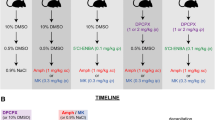Abstract
Kainic acid injections into the nucleus accumbens in rats induced severe loss of neuronal perikarya and the presence of gliosis in its vicinity, without affecting more distant areas. Spontaneous locomotor activity was elevated in the lesioned rats. After a low dose of d-amphetamine (1.5 mg/kg) no significant differences in locomotor activity were found between lesioned and sham-operated rats, while the increase in locomotor activity normally induced by a moderate dose of apomorphine (1 mg/kg) was blocked in lesioned rats. These results indicate that although dopamine receptors on the nucleus accumbens neurons are involved in the mechanisms mediating locomotor behaviour, the locomotor stimulant effect of d-amphetamine is not exclusively dependent on intra-accumbens dopaminergic activity.
Similar content being viewed by others
References
Carey RJ (1982) Septal lesions enhance hyperactivity induced either by amphetamine or lesions of the nucleus accumbens septi. Behav Brain Res 5:43–52
Cole SO (1978) Brain mechanisms of amphetamine-induced anorexia, locomotion and stereotypy. Neurosci Biobehav Rev 2:89–100
Costall B, Naylor RJ, Cannon JG, Lee T (1977) Differentiation of the dopamine mechanisms mediating stereotyped behaviour and hyperactivity in the nucleus accumbens and caudato-putamen. J Pharm Pharmacol 29:337–342
Costall B, Naylor RJ, Nohria V (1979) Hyperactivity response to apomorphine and amphetamine in the mouse: The importance of the nucleus accumbens and caudate-putamen. J Pharm Pharmacol 31:259–261
Coyle JT, Shwarcz R, Bennet JP, Campochiaro P (1979) Clinical, neuropathologic and pharmacological aspects of Huntington's disease: correlates with a new animal model. Prog Neuropsychopharmacol 1:13–30
Fink JS, Smith GP (1979) Abnormal pattern of amphetamine locomotion after 6-OHDA lesion of the anteromedial caudate. Pharmacol Biochem Behav 11:23–30
Fink JS, Smith GP (1980) Relationships between selective denervation of dopamine terminal fields in the anterior forebrain and behavioral responses to amphetamine and apomorphine. Brain Res 201:107–127
Iversen SD, Koob GF (1977) Behavioral implication of dopaminergic neurons in the mesolimbic system. In: Costa E, Gessa GL (eds) Advances in Biochemical Psychopharmacology, vol 31, Raven Press, New York, pp 209–214
Jackson DM, Anden NE, Dalhstrom A (1975) A functional effect of dopamine in the nucleus accumbens and in some other dopaminergic parts of the rat brain. Psychopharmacologia 45:139–149
Joyce EM, Stinus L, Iversen SD (1983) Effect of injections of 6-OHDA into either nucleus accumbens septi or frontal cortex on spontaneous and drug-induced activity. Neuropharmacology 22:1141–1145
Kehne JH, Sant WW, Sorenson CA (1981) The effects of radio-frequency lesions of the nucleus accumbens on d-amphetamine-induced locomotor and rearing behavior in rats. Psychopharmacology 75:363–367
Kelly PH, Iversen SD (1976) Selective 6-OHDA-induced destruction of mesolimbic dopamine neurons: Abolition of psycho-stimulant-induced locomotor activity in rats. Eur J Pharmacol 40:45–546
Kelly PH, Roberts DCS (1983) Effects of amphetamine and apomorphine on locomotor activity after 6-OHDA and electrolytic lesions of the nucleus accumbens septi. Pharmacol Biochem Behav 19:137–144
Kelly PH, Seviour PW, Iversen SD (1975) Amphetamine and apomorphine responses in the rat following 6-OHDA lesions of the nucleus accumbens septi and corpus striatum. Brain Res 94:507–522
Köhler C, Shwarcz R (1983) Comparison of ibotenate and kainate neurotoxicity in rat brain: A histological study. Neuroscience 8:819–835
Koob GF, Riley SJ, Smith SC, Robbins TW (1978) Effects of 6-hydroxydopamine lesions of the nucleus accumbens septi and olfactory tubercle on feeding, locomotor activity and amphetamine anorexia in the rat. J Comp Physiol Psychol 92:917–927
Lindvall O, Bjorklund A (1978) Anatomy of dopaminergic neuron systems in the rat brain. In: Roberts PJ, Woodruff GN, Iversen LL (eds) Advances in Biochemical Psychopharmacology, vol 19, Raven Press, New York, pp 1–23
Makanjuola RO, Ashcroft GW (1982) Behavioural effects of electrolytic and 6-hydroxydopamine lesions of the accumbens and the caudate-putamen nuclei. Psychopharmacology 76:33–40
Makanjuola ROA, Dow RC, Ashcroft GW (1980) Behavioural responses to stereotaxically controlled injections of monoamine neurotransmitters into the accumbens and caudate-putamen nuclei. Psychopharmacology 71:227–235
Mason ST, Sanberg PR, Fibiger HC (1978) Amphetamine-induced locomotor activity and stereotypy after kainic acid lesions of the striatum. Life Sci 22:451–460
Naalsund LU (1983) The toxic effect of kainic acid on neurotransmitters in nucleus accumbens. Eur J Pharmacol 96:137–140
Olney JW, Rhee V, Ho OL (1974) Kainic acid: a powerful neurotoxic analog of glutamate. Brain Res 77:507–512
Paxinos G, Watson C (1982) The rat brain in stereotaxic coordinates, Academic Press, New York
Pijnenburg AJJ, Honig WMM, Van der Heyden JAM, Van Rossum JM (1976) Effects of chemical stimulation of the mesolimbic dopamine system upon locomotor activity. Eur J Pharmacol 35:49–58
Pijnenburg AJJ, Honig WMM, Van Rossum JM (1975) Antagonism of apomorphine- and d-amphetamine-induced locomotor activity by injection of haloperidol into the nucleus accumbens of the rat. Psychopharmacologia 41:87–95
Snedecor GW, Cochran WG (1978) Statistical Methods, 6th edition, 9th printing, The Iowa State University Press, Ames, Iowa
Wirtshafter D, Asin KE, Kent EW (1978) Nucleus accumbens lesions reduce amphetamine hyperthermia, but not hyperactivity. Eur J Pharmacol 51:449–452
Zaczek R, Simonton R, Coyle JT (1980) Local and distant neuronal degeneration following intrastriatal injection of kainic acid. J Neuropathol Exp Neurol 39:245–264
Author information
Authors and Affiliations
Rights and permissions
About this article
Cite this article
Kafetzopoulos, E. Effects of amphetamine and apomorphine on locomotor activity after kainic acid lesion of the nucleus accumbens septi in the rat. Psychopharmacology 88, 271–274 (1986). https://doi.org/10.1007/BF00180823
Received:
Revised:
Issue Date:
DOI: https://doi.org/10.1007/BF00180823



